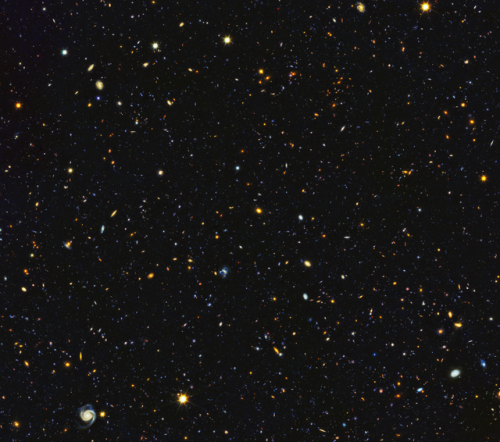In October 1980 The Voyager Probe Discovered Three Small Moons Of Saturn, Pandora, Atlas And Prometheus.










In October 1980 the Voyager probe discovered three small moons of Saturn, Pandora, Atlas and Prometheus. (source & images)
More Posts from Ocrim1967 and Others
Galactic Ghouls and Stellar Screams
A quiet, starry night sky might not seem like a very spooky spectacle, but space can be a creepy place! Monsters lurk in the shadowy depths of the universe, sometimes hidden in plain sight. Many of them are invisible to our eyes, so we have to use special telescopes to see them. Read on to discover some of these strange cosmic beasts, but beware — sometimes fact is scarier than fiction.
Monster Black Holes ⚫

You know those nightmares where no matter how fast you try to run you never seem to get anywhere? Black holes are a sinister possible version of that dream — especially because they’re real! If you get too close to a black hole, there is no possibility of escape.
Just last year our Fermi Gamma-ray Space Telescope traced an otherworldly ghost particle back to one of these monster black holes, providing additional insight into the many signals we’re picking up from some of the most feared creatures in the cosmic deep.
But it gets worse. Our Hubble Space Telescope revealed that these things are hidden in the hearts of nearly every galaxy in the universe. That means supermassive black holes lurk in the shadows of the night sky in every direction you look!
A Hazy Specter 👻

This fiendish specter lives in the center of the Milky Way, haunting our galaxy’s supermassive black hole. But it’s not as scary as it looks! Our SOFIA observatory captured streamlines tracing a magnetic field that appears to be luring most of the material quietly into orbit around the black hole. In other galaxies, magnetic fields seem to be feeding material into hungry black holes — beware! Magnetic fields might be the answer to why some black holes are starving while others are feasting.
Bats in the Belfry 🦇

The universe has bats in the attic! Hubble spotted the shadow of a giant cosmic bat in the Serpens Nebula. Newborn stars like the one at the center of the bat, called HBC 672, are surrounded by disks of material, which are hard to study directly. The shadows they cast, like the bat, can clue scientists in on things like the disk’s size and density. Our solar system formed from the same type of disk of material, but we can only see the end result of planet building here — we want to learn more about the process!
Jack-o-lantern Sun 🎃

A jack-o-lantern in space?! Our Solar Dynamics Observatory watches the Sun at all times, keeping a close eye on space weather. In October 2014, the observatory captured a chilling image of the Sun with a Halloweenish face!
Skull Comet 💀

On Halloween a few years ago, an eerie-looking object known as 2015 TB145 sped across the night sky. Scientists observing it with our Infrared Telescope Facility determined that it was most likely a dead comet. It’s important to study objects like comets and asteroids because they’re dangerous if they cross Earth’s path — just ask the dinosaurs!
Halloween Treat 🍬

Trick-or-treat! Add a piece of glowing cosmic candy to your Halloween haul, courtesy of Hubble! This image shows the Saturn Nebula, formed from the outer layers ejected by a dying star, destined to be recycled into later generations of stars and planets. Our Sun will experience a similar fate in around five billion years.
Witch’s Broom Nebula 🧹

Massive stars are in for a more fiery fate, as the Witch’s Broom Nebula shows. Hubble’s close-up look reveals wisps of gas — shrapnel leftover from a supernova explosion. Astronomers believe that a couple of supernovae occur each century in galaxies like our own Milky Way.
Zombie Stars 🧟

Supernovae usually herald the death of a star, but on a few occasions astronomers have found “zombie stars” left behind after unusually weak supernovae. Our Nuclear Spectroscopic Telescope Array (NuSTAR) has even spotted a mysterious glow of high-energy X-rays that could be the “howls” of dead stars as they feed on their neighbors.
Intergalactic Ghost Towns 🏚️

The universe is brimming with galaxies, but it’s also speckled with some enormous empty pockets of space, too. These giant ghost towns, called voids, may be some of the largest things in the cosmos, and since the universe is expanding, galaxies are racing even farther away from each other all the time! Be grateful for your place in space — the shadowy patches of the universe are dreadful lonely scenes.
Mysterious Invisible Force 🕵️♀️

Some forces are a lot spookier than floorboards creaking or a door slamming shut unexpectedly when you’re home alone. Dark energy is a mysterious antigravity pressure that our Wide Field Infrared Survey Telescope (WFIRST) is going to help us understand. All we know so far is that it’s present everywhere in the cosmos (even in the room with you as you read this) and it controls the fate of the universe, but WFIRST will study hundreds of millions of galaxies to figure out just what dark energy is up to.
Want to learn some fun ways to celebrate Halloween in (NASA) style? Check out this link!
Make sure to follow us on Tumblr for your regular dose of space: http://nasa.tumblr.com
All cats are beautiful 🐱❤️





















Astronomers have just assembled one of the most comprehensive portraits yet of the universe’s evolutionary history, based on a broad spectrum of observations by the Hubble Space Telescope and other space and ground-based telescopes. In particular, Hubble’s ultraviolet vision opens a new window on the evolving universe, tracking the birth of stars over the last 11 billion years back to the cosmos’ busiest star-forming period, about 3 billion years after the big bang. This photo encompasses a sea of approximately 15,000 galaxies — 12,000 of which are star-forming — widely distributed in time and space. This mosaic is 14 times the area of the Hubble Ultra Violet Ultra Deep Field released in 2014.
Credits: NASA, ESA, P. Oesch (University of Geneva), and M. Montes (University of New South Wales)










(Source)

Pulsar planets are planets that are found orbiting pulsars, or rapidly rotating neutron stars. The first such planet to be discovered was around a millisecond pulsar and was the first extrasolar planet to be confirmed as discovered.
source











Ten Solstice Facts That Everyone Should Know
“9.) The solstices are neither the hottest nor coldest days of the year. This one is actually very specific to Earth: the hottest times of the year typically correspond to approximately 6 weeks after the summer solstice, and approximately 6 weeks after the winter solstice. Other planets don’t have this same phenomenon for one very important reason: they don’t have the majority of their surfaces covered in liquid water.
The oceans themselves, being composed of large quantities of water and containing approximately 1,000 times the mass of Earth’s atmospheres, contain a tremendous amount of heat, and are slow to change their temperatures. We might receive more (or less) energy from the Sun on the summer (or winter) solstices, but the oceans require time to heat up or cool down. Global average temperature extremes, therefore, usually occur in early August and February, rather than at the June and December solstices.”
The solstice, Latin for the Sun standing still in the sky, occurs whenever the Earth’s axial tilt reaches a maximum relative to the Earth’s orbital plane around the Sun. With a tilt of 23.5 degrees, but a tilt that’s independent of our elliptical orbit around the Sun, many surprising and counterintuitive facts arise.
Want to know as many of them as possible? Come get this remarkable and fascinating list of educational facts on this year’s solstice: June 21, 2019!










7 Fascinating Facts About 2019’s Only Total Solar Eclipse
“3.) Optimally situated viewers will experience 4 minutes and 33 seconds of totality. With Earth near aphelion and the Moon near perigee, it’s nearly twice the duration of 2017’s eclipse.”
On July 2, 2019, the world will experience a total solar eclipse: the only one of the year. Unlike the famous 2017 solar eclipse which spanned the continental United States, this year’s total solar eclipse occurs almost exactly coincident with both lunar perigee, where the Moon is closest to Earth, and solar aphelion, where the Sun is at its farthest point from Earth. July 2nd is just 2 days before our annual aphelion and 3 days before our monthly perigee, meaning that we’ll get 4 minutes and 33 seconds of totality during maximum eclipse: nearly twice as long as 2017′s maximum totality and the longest total solar eclipse we’ll experience until 2027.
What will we learn? What will we see? And how can you observe it from anywhere in the world? Find out these and more amazing facts before the eclipse passes!
Three Ways to Travel at (Nearly) the Speed of Light

One hundred years ago, Einstein’s theory of general relativity was supported by the results of a solar eclipse experiment. Even before that, Einstein had developed the theory of special relativity — a way of understanding how light travels through space.
Particles of light — photons — travel through a vacuum at a constant pace of more than 670 million miles per hour.

All across space, from black holes to our near-Earth environment, particles are being accelerated to incredible speeds — some even reaching 99.9% the speed of light! By studying these super fast particles, we can learn more about our galactic neighborhood.
Here are three ways particles can accelerate:
1) Electromagnetic Fields!
Electromagnetic fields are the same forces that keep magnets on your fridge! The two components — electric and magnetic fields — work together to whisk particles at super fast speeds throughout the universe. In the right conditions, electromagnetic fields can accelerate particles at near-light-speed.

We can harness electric fields to accelerate particles to similar speeds on Earth! Particle accelerators, like the Large Hadron Collider and Fermilab, use pulsed electromagnetic fields to smash together particles and produce collisions with immense amounts of energy. These experiments help scientists understand the Big Bang and how it shaped the universe!
2) Magnetic Explosions!

Magnetic fields are everywhere in space, encircling Earth and spanning the solar system. When these magnetic fields run into each other, they can become tangled. When the tension between the crossed lines becomes too great, the lines explosively snap and realign in a process known as magnetic reconnection. Scientists suspect this is one way that particles — for example, the solar wind, which is the constant stream of charged particles from the Sun — are sped up to super fast speeds.

When magnetic reconnection occurs on the side of Earth facing away from the Sun, the particles can be hurled into Earth’s upper atmosphere where they spark the auroras.
3) Wave-Particle Interactions!

Particles can be accelerated by interactions with electromagnetic waves, called wave-particle interactions. When electromagnetic waves collide, their fields can become compressed. Charged particles bounce back and forth between the waves, like a ball bouncing between two merging walls. These types of interactions are constantly occurring in near-Earth space and are responsible for damaging electronics on spacecraft and satellites in space.

Wave-particle interactions might also be responsible for accelerating some cosmic rays from outside our solar system. After a supernova explosion, a hot, dense shell of compressed gas called a blast wave is ejected away from the stellar core. Wave-particle interactions in these bubbles can launch high-energy cosmic rays at 99.6% the speed of light.
Make sure to follow us on Tumblr for your regular dose of space: http://nasa.tumblr.com.










He faced all this for you, for you to be loved, blessed, glorified, exalted, satisfied, accepted, freed and resurrected.
-
 gueule-de-contact liked this · 9 months ago
gueule-de-contact liked this · 9 months ago -
 darkwindows24 liked this · 1 year ago
darkwindows24 liked this · 1 year ago -
 rllygoodboi liked this · 2 years ago
rllygoodboi liked this · 2 years ago -
 thalassemia liked this · 2 years ago
thalassemia liked this · 2 years ago -
 magickneesocks liked this · 2 years ago
magickneesocks liked this · 2 years ago -
 dunnoidcbye reblogged this · 3 years ago
dunnoidcbye reblogged this · 3 years ago -
 dunnoidcbye liked this · 3 years ago
dunnoidcbye liked this · 3 years ago -
 sntg liked this · 4 years ago
sntg liked this · 4 years ago -
 itsderry liked this · 4 years ago
itsderry liked this · 4 years ago -
 famehooka reblogged this · 4 years ago
famehooka reblogged this · 4 years ago -
 hitglo liked this · 4 years ago
hitglo liked this · 4 years ago -
 geminis900 liked this · 4 years ago
geminis900 liked this · 4 years ago -
 sunmunn reblogged this · 4 years ago
sunmunn reblogged this · 4 years ago -
 thatforestprince liked this · 4 years ago
thatforestprince liked this · 4 years ago -
 queendaisy liked this · 4 years ago
queendaisy liked this · 4 years ago -
 cacahuate-sii reblogged this · 4 years ago
cacahuate-sii reblogged this · 4 years ago -
 ameetingplace reblogged this · 4 years ago
ameetingplace reblogged this · 4 years ago -
 derianbehrooz liked this · 4 years ago
derianbehrooz liked this · 4 years ago -
 is-this-lit liked this · 4 years ago
is-this-lit liked this · 4 years ago -
 holo-bionte reblogged this · 4 years ago
holo-bionte reblogged this · 4 years ago -
 thespinningdalek reblogged this · 4 years ago
thespinningdalek reblogged this · 4 years ago -
 arbuthnotblob liked this · 5 years ago
arbuthnotblob liked this · 5 years ago -
 sweetwhitechoco liked this · 5 years ago
sweetwhitechoco liked this · 5 years ago -
 dizzydaisygettinglazy reblogged this · 5 years ago
dizzydaisygettinglazy reblogged this · 5 years ago -
 supralunar liked this · 5 years ago
supralunar liked this · 5 years ago -
 emptyanddark liked this · 5 years ago
emptyanddark liked this · 5 years ago -
 qhos reblogged this · 5 years ago
qhos reblogged this · 5 years ago -
 emmanue77e liked this · 5 years ago
emmanue77e liked this · 5 years ago -
 cinnamon-passion-boy reblogged this · 5 years ago
cinnamon-passion-boy reblogged this · 5 years ago -
 cinnamon-passion-boy liked this · 5 years ago
cinnamon-passion-boy liked this · 5 years ago -
 cacahuate-sii reblogged this · 5 years ago
cacahuate-sii reblogged this · 5 years ago -
 space-up-my-sleeve reblogged this · 5 years ago
space-up-my-sleeve reblogged this · 5 years ago -
 cannedmonster reblogged this · 5 years ago
cannedmonster reblogged this · 5 years ago -
 entropicrumination reblogged this · 5 years ago
entropicrumination reblogged this · 5 years ago -
 brawgavin liked this · 5 years ago
brawgavin liked this · 5 years ago -
 hoolahoopsmcgee reblogged this · 5 years ago
hoolahoopsmcgee reblogged this · 5 years ago -
 moved-the-coin liked this · 5 years ago
moved-the-coin liked this · 5 years ago -
 yeahthatsnormal reblogged this · 5 years ago
yeahthatsnormal reblogged this · 5 years ago -
 thespinningdalek liked this · 5 years ago
thespinningdalek liked this · 5 years ago -
 lupismaris reblogged this · 5 years ago
lupismaris reblogged this · 5 years ago -
 lupismaris liked this · 5 years ago
lupismaris liked this · 5 years ago -
 danvvrs-archive reblogged this · 5 years ago
danvvrs-archive reblogged this · 5 years ago -
 stelaernis liked this · 5 years ago
stelaernis liked this · 5 years ago